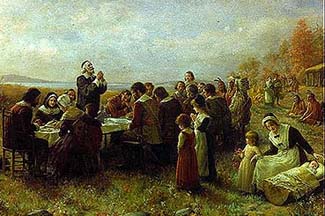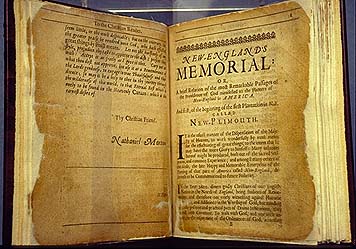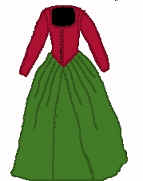|
The Puritans and their religion. The
Puritans were a group of people who grew discontent in the Church of
England and worked towards religious, moral and societal reforms. The
writings and ideas of John Calvin, a leader in the Reformation, gave
rise to Protestantism and were pivotal to the Christian revolt.They
contended that The Church of England had become a product of political
struggles and man-made doctrines. The Puritans were one branch of
dissenters who decided that The Church of England was beyond reform.
Escaping persecution from church leadership and the King, they came to
America. The
Puritans believed that the Bible was God’s true law, and that it
provided a plan for living. The established church of the day described
access to God as monastic and possible only within the confines of
“church authority. Puritans stripped away the traditional trappings
and formalities of Christianity which had been slowly building
throughout the previous 1500 years. Theirs was an attempt to
“purify’ the church and their own lives. Most
of the Puritans settled in the New England area. As the immigrated and
formed individual colonies, their numbers rose from 17,800 in 1640 to
106,000 in 1700. Religious exclusiveness was the foremost principle of
their society. The spiritual beliefs that they held were strong. This
strength held over to include community laws and customs. Since God was
at the forefront of their minds, He was to motivate all of their actions.
This premise worked both for them and against them. The
common unity strengthened the community. In a foreign land surrounded
with the hardships of pioneer life, their spiritual bond made them
sympathetic to each other’s needs. Their overall survival techniques
permeated the colonies and on the whole made them more successful in
several areas beyond that of the colonies established to their south. Each
church congregation was to individually responsible to God, as was each
person. The New Testament was their model and their devotion so great
that it permeated their entire society. People of opposing theological
views were asked to leave the community or to be converted. Their
interpretation of scriptures was a harsh one. They emphasised a
redemptive piety. In principle, they emphasised conversion and not
repression. Conversion was a rejection of the The
doctrine of predestination kept all Puritans constantly working to do
good in this lift to be chosen for the next eternal one. God had already
chosen who would be in heaven or hell, and each believer had no way of
knowing which group they were in. Those who were wealthy were obviously
blessed by God and were in good standing with Him. The Protestant work
ethic was the belief that hard work was an honour to God which would
lead to a prosperous reward. Any deviations from the normal way of
Puritan life met with strict disapproval and discipline. Since the
church elders were also political leaders, any church infraction was
also a social one. There was no margin for error. The
devil was behind every evil deed. Constant watch needed to be kept in
order to stay away from his clutches. Words of hell fire and brimstone
flowed from the mouths of eloquent ministers as they warned of the
persuasiveness of the devil’s power. The sermons of Jonathan Edwards,
a Puritan minister, show that delivery of these sermons became an art
form. They were elegant, well-formed, exegetical renditions of
scriptures, with a healthy dose of fear woven throughout the fabric of
the literary construction. Grammar children were quizzed on the material
at school and at home. This constant subjection of the probability of an
unseen danger led to a scandal of epidemic proportions. In
1688, four young girls accused a laundry woman of “bewitching” them.
What could have been stopped progressed into a community tragedy. The
young women enjoyed the attention this story afforded them, but no doubt
were afraid that their lies would be found out. In an effort to further
punctuate their story, they lapsed into prolonged convulsions. Those who
were “possessed by the devil” were forced to make confessions of
their evil liaisons in order to protect their families and properties
from harm. Those who denounced witchcraft (thereby calling the witnesses
liars) were then accused themselves. In the frenzy to follow, by 1690
two hundred persons were in jail, fifty in prison and twenty executed (along
with 2 dogs). Cotton Mather, a leader of the group, quietly led the way
in bringing this crisis to an end. The devotion they held in maintaining
a religious society in isolation fuelled the fire of the witchcraft
scandal. Great
pains were taken to warn their members and especially their children of
the dangers of the world. Religiously motivated, they were exceptional
in their time for their interest in the education of their children.
Reading of the Bible was necessary to living a pious life. The education
of the next generation was important to further “purify” the church
and perfect social living. Three
English diversions were banned in their New England colonies, drams,
religious music and erotic poetry. The first and last of these led to
immorality. Music in worship created a “dreamy” state which was not
conducive in listening to God. Since the people were not spending their
time idly indulged in trivialities, they were left with two godly
diversions. The
Bible stimulated their corporate intellect by promoting discussions of
literature. Greek classics of Cicero, Virgil, Terence and Ovid were
taught, as well as poetry and Latin verse. They were encouraged to
create their own poetry, always religious in content. For
the first time in history, free schooling was offered for all children.
Puritans formed the first formal school in 1636, called Roxbury Latin
School. Four years later, the first American College was established;
Harvard in Cambridge. Children aged 6-8 attended a “Dame school”
where the teacher, who was usually a widow, taught reading. “Ciphering”(maths)
and writing were low on the academic agenda. In
1638, the first printing press arrived. By 1700, Boston became the
second largest publishing centre of the English Empire. The Puritans
were the first to write books for children, and to discuss the
difficulties in communicating with them. At a time when other Americans
were physically blazing trails through the forests, the Puritans efforts
in areas of study were advancing the country intellectually. Religion
provided a stimulus and prelude for scientific thought. Of those
Americans who were admitted into the scientific “Royal Society of
London” the vast majority were New England Puritans. The
large number of people who ascribed to the lifestyle of the Puritans did
much to firmly establish a presence on American soil. Bound together,
they established a community that maintained a healthy economy,
established a school system, and focussed an efficient eye on political
concerns. The moral character of England and America were shaped in part
by the words and actions of this strong group of Christian believers
called the Puritans.
|
 click on the picture
click on the picture
The first Thanksgiving at Plymouth
(By Jennie A. Brownscombe)
|

The Geneva Bible used by Mayflower Pilgrim
William Bradford, published in 1592. |
|
The
clothes of
the women. A woman's undergarment was a long off-white short-sleeved, linen shirt, resembling a modern-day woman's nightshirt except that it was ribbon-tied at the collar and cuffs and fastened in the front. One or more ankle-length, waist-fastened petticoats were worn. The dress, or gown, consisted of two parts, a bodice and a skirt--sometimes the sleeves were a separate part as well, being tied to the bodice. The bodice or the skirt could be the same or different colors, and were made of wool. The bodice buttoned all the way down the front. The skirt was ankle-length and gathered at the waist. A long-sleeve fitted waistcoat was often worn over the top, and an apron was worn if the woman was doing any kind of work. Women occasionally wore lace collar and cuffs, and a cloak. Women's hair was always worn up and pulled tightly back, and worn under a coif (bonnet) or hat
|
